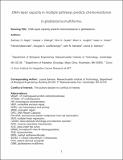DNA repair capacity in multiple pathways predicts chemoresistance in glioblastoma multiforme
Author(s)
Kitange, Gaspar J.; Gupta, Shiv K.; Sarkaria, Jann N.; Nagel, Zachary D.; Joughin, Brian Alan; Chaim, Isaac Alexander; Mazzucato, Patrizia; Lauffenburger, Douglas A; Samson, Leona D; ... Show more Show less
Downloadznagel_cancerres_preprint.pdf (640.7Kb)
OPEN_ACCESS_POLICY
Open Access Policy
Creative Commons Attribution-Noncommercial-Share Alike
Terms of use
Metadata
Show full item recordAbstract
Cancer cells can resist the effects of DNA-damaging therapeutic agents via utilization of DNA repair pathways, suggesting that DNA repair capacity (DRC) measurements in cancer cells could be used to identify patients most likely to respond to treatment. However, the limitations of available technologies have so far precluded adoption of this approach in the clinic. We recently developed fluorescence-based multiplexed host cell reactivation (FM-HCR) assays to measure DRC in multiple pathways. Here we apply a mathematical model that uses DRC in multiple pathways to predict cellular resistance to killing by DNA-damaging agents. This model, developed using FM-HCR and drug sensitivity measurements in 24 human lymphoblastoid cell lines, was applied to a panel of 12 patient-derived xenograft (PDX) models of glioblastoma (GBM) to predict GBM response to treatment with the chemotherapeutic DNA damaging agent temozolomide (TMZ). This work showed that, in addition to changes in O6-methylguanine DNA methyltransferase (MGMT) activity, small changes in mismatch repair (MMR), nucleotide excision repair (NER), and homologous recombination (HR) capacity contributed to acquired TMZ resistance in PDX models, and lead to reduced relative survival prolongation following TMZ treatment of orthotopic mouse models in vivo. Our data indicate that measuring the combined status of MMR, HR, NER, and MGMT provided a more robust prediction of TMZ resistance than assessments of MGMT activity alone.
Date issued
2016-10Department
Massachusetts Institute of Technology. Department of Biological Engineering; Koch Institute for Integrative Cancer Research at MITJournal
Cancer Research
Publisher
American Association for Cancer Research (AACR)
Citation
Nagel, Zachary D., Gaspar J. Kitange, Shiv K. Gupta, Brian A. Joughin, Isaac A. Chaim, Patrizia Mazzucato, Douglas A. Lauffenburger, Jann N. Sarkaria, and Leona D. Samson. “DNA Repair Capacity in Multiple Pathways Predicts Chemoresistance in Glioblastoma Multiforme.” Cancer Research (October 28, 2016).
Version: Author's final manuscript
ISSN
0008-5472
1538-7445